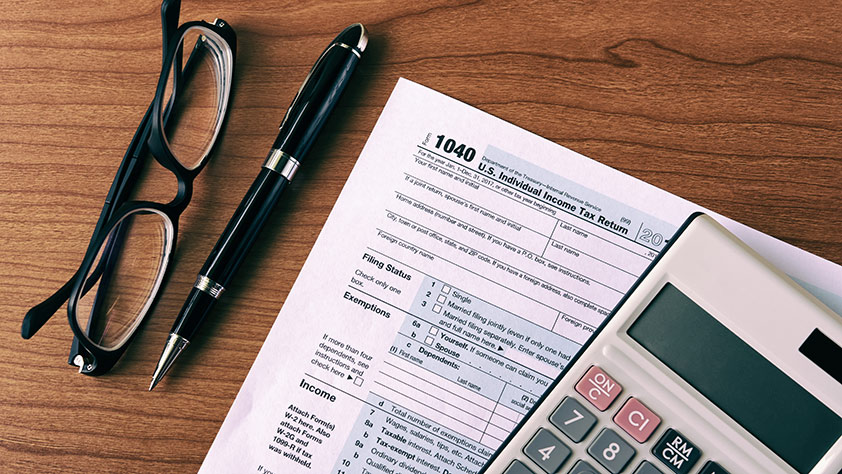Key takeaways
- Most retirement income is taxable except for withdrawals from Roth retirement accounts.
- Having taxable and non-taxable accounts gives you more tax planning flexibility.
- At a certain age, you must take minimum distributions from tax-deferred retirement accounts.
One of the biggest challenges in retirement is managing your retirement income so it lasts throughout your lifetime. A lot of time and effort is spent on maintaining diversified investment portfolios and limiting principal withdrawals from retirement accounts. While those strategies are important, many retirees overlook tax planning and may end up paying more money to Uncle Sam than necessary.
Give your retirement income taxable and non-taxable flexibility
Before you can put tax strategies into place, you need to understand which sources of income are taxable and which aren’t. Understanding how your retirement income is taxed and then selectively withdrawing money across different types of taxable and non-taxable accounts may offer the most flexibility for minimizing your tax bite.
Here’s a look at which of two tax buckets common retirement income sources fall into.
1. Taxable bucket. Withdrawals and payments from these sources generally are taxed at your regular income tax rate in the year you receive them:
- Pension payments
- Withdrawals of pre-tax contributions and all investment earnings from 403(b) plans, 401(k) plans, Traditional IRAs and other tax-deferred retirement savings plans
- A portion of Social Security payments depending on certain criteria. Up to 85% of Social Security payments may be taxable if you have income from other sources.
- Interest on regular savings accounts and income from interest and dividends paid through taxable brokerage accounts
2. Non-Taxable bucket. Income from these sources generally is tax-free at the time of withdrawal:
- Withdrawals of any after-tax contributions (but not earnings on those contributions) made to 403(b) plans, 401(k) plans, Traditional IRAs and other tax-deferred retirement savings plans
- Qualified withdrawals from Roth 403(b)s, Roth 401(k)s and Roth IRAs
- Social Security payments (if your income falls below certain limits)
- Certain municipal bonds
Decide how and when to take withdrawals from retirement accounts
You’ll want to design a withdrawal strategy from your retirement accounts, including the total percentage of assets you take out and which accounts you tap first.
A simple method that’s long been put forth as a default strategy, suggests taking withdrawals in this order:
- Required Minimum Distributions (RMDs) from retirement accounts
- Taxable accounts (savings, brokerage)
- Tax-deferred retirement accounts (403(b), Traditional IRA)
- Tax-free retirement accounts (Roth 403(b), Roth 401(k), Roth IRA)
But there are no hard and fast rules. Everyone’s tax situation is unique and requires individual planning to get the most tax benefits. Plus, tax liabilities change over time. Tax rates may go up or down and the balances in your taxable and non-taxable accounts may vary due to investment performance and withdrawals. You’ll have the most flexibility if you have money in all of these different account types. Then you can be nimble in how you take your withdrawals depending on your income and tax situation each year.
For example, if you have savings in both a 403(b) plan and a Roth IRA, you might withdraw just enough taxable income from the 403(b) to avoid getting bumped into a higher tax bracket. You could then take tax-free withdrawals from the Roth IRA for additional income without paying more taxes.
Remember to take Required Minimum Distributions (RMDs)
Once you reach a certain age, the IRS requires you to take minimum distributions from all tax-deferred retirement accounts each year whether you need the income or not. These distributions are taxable, so they will drive your decisions on where to take other withdrawals in order to minimize additional taxes.
The rules around RMDs changed, first through the SECURE (Setting Every Community Up for Retirement Enhancement) Act in December 2019, and then by the CARES (Coronavirus Aid, Relief and Economic Security) Act, in response to the COVID-19 crisis in March 2020.
The SECURE Act increased the age at which distributions are required, and the CARES Act waived some mandatory distributions.
- If you turned 70½ in 2019, you were required to take your first RMD by April 1, 2020. Then, the CARES Act waived any distributions that had been required to be taken in 2020.
- According to the new SECURE Act, if you turn 70½ in 2020 or later, then you must take your first RMD by April 1 of the year after you reach 72.
The IRS is very strict about enforcing RMD rules, so make sure you calculate your RMDs correctly and make them on time. If you’re late, you’ll owe a penalty equal to 50 percent of the amount that should have been withdrawn.
Get creative to limit tax liabilities
You can employ many of the same tax limiting strategies in retirement that you did when you were working and earning a paycheck.
- File itemize tax returns so you can maximize deductions (if you have the deductions)
- Make charitable gifts
- If you are in the lowest tax brackets, you may be able to sell stocks and take long-term capital gains tax-free
- If you are in higher tax brackets, you may be able to sell stocks at a loss to offset a portion of your income
- Work with a financial planner and tax advisor to take advantage of all your options.
Tax planning in retirement is complex, thanks to multiple income sources each with different tax liabilities and the need to take RMDs. Consult with your tax advisor to come up with a flexible plan that provides the income you need while minimizing the taxes you pay. It’s a constantly evolving process, so the strategies you use this year may change next year.












